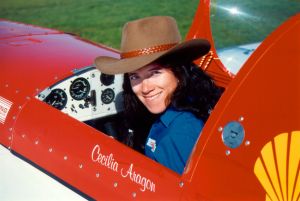Everyone just thought she had lost her mind.
Cecilia Aragon had earned her degree in mathematics from the California Institute of Technology, published seminal research in computer science and had embarked on a promising career as a software development expert in Palo Alto.
But she knew she was still afraid. Academic achievement helped, Aragon says, but she still felt governed by her phobias – which included a fear of flying.
“One day a friend asked me to go on an airplane ride,” she recalls. “I mean, I was scared even of driving a car back then. I was scared to talk to people. I decided then that I needed to break through all these walls around me and face my fear.”
Aragon went on that plane ride and fell in love with flying, quit her programming job and decided to become a pilot. And did she ever face her fears.
Aragon began flying full time and moved quickly into aerobatics and stunts. In 1991, she won a slot on the U.S. Aerobatic Team, setting a record for the shortest time from first solo flight to membership on the elite flying team. She’s won numerous honors as a pilot, including bronze medals at the 1993 U.S. National Aerobatic Championship and 1994 World Aerobatic Championship.
Aragon also founded one of the first aerobatic flight schools in Northern California and continues to work as a flight instructor. Eventually, the scientist in her regained control of the stick and she returned to the ground to pursue research.
One area where her flying and science dovetail is her pioneering work in “unusual attitude recovery” – training pilots how to recover from emergency situations in flight. Outside her science and flying, Aragon often helps others in different kinds of “attitude recovery” – using her own story to help students and colleagues deal with their own fears or anxieties.
She is a founding member of Latinas in Computing and especially enjoys encouraging young women to pursue careers in science. She lives with her husband and two children in the San Francisco Bay area.
